©
2004 Jeff Matthews & napoli.com
April
Fool's Day—
 Many
glaciations ago, A Neanderthal Person with a corresponding sense of
humor pasted prehistory's first "Please Club Me" sign to the back of
an unsuspecting fellow missing–link, whom fun–loving passers–by
then bludgeoned into gristle, a process that garnered boffo yuks from
the cave crowd. "Whew! That silly chap certainly was some April Fool,
n'est-ce pas?", they chortled, thus naming a month and starting
a glorious tradition much loved by all those who have ever found their
shoes nailed to the floor. Many
glaciations ago, A Neanderthal Person with a corresponding sense of
humor pasted prehistory's first "Please Club Me" sign to the back of
an unsuspecting fellow missing–link, whom fun–loving passers–by
then bludgeoned into gristle, a process that garnered boffo yuks from
the cave crowd. "Whew! That silly chap certainly was some April Fool,
n'est-ce pas?", they chortled, thus naming a month and starting
a glorious tradition much loved by all those who have ever found their
shoes nailed to the floor.
Playing
tricks on others goes way, way back. We get our word "jovial" from the
great god Jove who is said to have been quite a jokester up there on
the Big O. Looking to spice up the blandness of omnipotence, so to speak,
he once confronted Vulcan and pointed to an imaginary spot on this lesser
deity's toga, bidding him behold, for, yea, the raiment was soiled with
ash from the Heavenly Forge. When the Fire God looked down, the Jovial
One brought his index-finger up and flicked him one right in the old
schnozzola! Verily, the welkins rangeth all over the placeth with the
sound of celestial guffaws and congratulatory high–fiveing. Vulcan,
on the other hand—a sorehead at best—erupted and destroyed
the Minoan civilization on Crete.
There is
no evidence that any of this happened on April First, so–called
"April Fools' " or "All–Fools' Day". In fact, there is no certainty
why any of this takes place on April First, at all. There was the festival
of Hilaria in ancient Rome (hot-footing sandals, getting locked in the
vomitorium—that sort of thing, one supposes) and a similar Hindu
festival called Holi. Both of these took place on or close to the Vernal
Equinox. What better time to play tricks than a time of the year when
Nature, herself, does the same? A more prosaic explanation is that when
various cultures went over to calendars that moved the celebration of
the New Year from the spring back to January first, news traveled so
slowly that there were still plenty of people who sent New Year's greetings
and gifts at the wrong time of the year and this degenerated into the
sending of mock gifts to the "fools" who didn't even know when the year
started.
In Italy
the April Fool is called "Pesce d'aprile" (April fish). This stems from
the fact that an increase of young fish is noted at this time of year
and the young fish are easily "hooked". Or at least that's the story,
but I heard it on April Fool's Day, so who knows? Fortunately, April
Fool's Day is not much of an Italian custom, much less one particular
to Naples. There is a day for playing stupid practical jokes on people;
that is at carnevale—Mardi gras. There is even a stupid bit of
doggerel to cover it: "A Carnevale ogni scherzo vale" (At Mardi
gras, all tricks are fair). That is when someone might spray you with
shaving cream or throw an egg at you. But there don't seem to be any
elaborate April Fool's pranks. For example, in some places back when
people still drove buggies, and April Fool's Day happened to fall on
a Sunday, a favorite prank was to skip the service and spend the time
hitching horses up to the wrong carriages and then stand around and
watch the fun when church let out. And the BBC once broadcast an April
Fool's documentary purporting to show, among other things, the spaghetti
"harvest" in Italy, including footage of peasants happily picking the
strands of pasta directly from the trees. I don't recall any such elaborate
trickery on April Fool's day around here.
Duomo
(Cathedral)
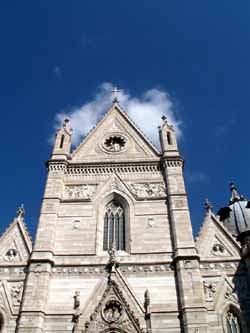 The
Duomo, the cathedral of Naples, is dedicated to San Gennaro,
Saint Januarius, the patron saint of the city. It was built at the end
of the 13th century at the decree of Charles I of Angiò near
the basilica of Santa Restituta (of which more, below), a sixth-century
church that was incorporated into the Gothic architecture of the later
cathedral, itself. The cathedral has been restored numerous times over
the centuries. It was redone after the earthquake of 1788 and again
in 1887. Its marble portals, however, are original. The
Duomo, the cathedral of Naples, is dedicated to San Gennaro,
Saint Januarius, the patron saint of the city. It was built at the end
of the 13th century at the decree of Charles I of Angiò near
the basilica of Santa Restituta (of which more, below), a sixth-century
church that was incorporated into the Gothic architecture of the later
cathedral, itself. The cathedral has been restored numerous times over
the centuries. It was redone after the earthquake of 1788 and again
in 1887. Its marble portals, however, are original.
Inside,
the cathedral is 100 meters long and in the form of a Latin Cross, with
three naves, divided by sixteen pillars that form Gothic arches and
incorporate 110 granite columns. The ceiling of the central nave is
of wood and bears five paintings by various artists: the Annunciation,
the Presentation at the Temple, the Visitation, the Nativity and the
Epiphany. High on the Walls of the central nave and the transept are
paintings of saints done by Luca Giordano and his school; at the base
of the pillars are busts of the first 16 bishops of the city of Naples.
Above the
door of the main entrance are monuments to Charles I of Angiò
(d. 1285) in the center; Charles Martel, King of Hungary (d. 1295) on
the right; and his wife Clemenza of Hapsburg (d. 1295) on the left.
These monuments are the work of Domenico Fontana; viceroy Enrico Guzman
Count of Olivares ordered them built in 1599 because the original tombs
of those nobles had been destroyed.The side chapels are all quite interesting,
containing, as they do, a collection of funerary items, sculpture, frescoes
and canvases that represent an exhaustive overview of figurative art
from 1200 to 1700.
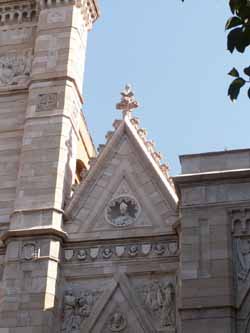 In
the nave, the fourth chapel is the Brancaccio chapel; just beyond that
you enter into the oldest part of the Cathedral, the Santa Restituta
basilica, one of the most interesting examples of paleo-Christian Naples.
Originally, it was a church in its own right, built in the 6th century.
Its present three aisles divided by 27 antique columns are what is left
of the original church after it was incorporated into the body of the
massive new cathedral in the 13th century. They say that Santa Restituta
was a young African woman, who, because she was a Christian, was abandoned
to the sea on a boat set ablaze. The fire, however, died out and she
was miraculously able to put ashore on the island of Ischia. In the
eighth century her remains were brought to the church in Naples that
then took her name. In
the nave, the fourth chapel is the Brancaccio chapel; just beyond that
you enter into the oldest part of the Cathedral, the Santa Restituta
basilica, one of the most interesting examples of paleo-Christian Naples.
Originally, it was a church in its own right, built in the 6th century.
Its present three aisles divided by 27 antique columns are what is left
of the original church after it was incorporated into the body of the
massive new cathedral in the 13th century. They say that Santa Restituta
was a young African woman, who, because she was a Christian, was abandoned
to the sea on a boat set ablaze. The fire, however, died out and she
was miraculously able to put ashore on the island of Ischia. In the
eighth century her remains were brought to the church in Naples that
then took her name.
Opposite
the Gothic Santa Restituta is the Baroque chapel of San Gennaro del Tesoro, built between 1608 and
1637 to fulfill the vow made by the people of Naples on January 13,
1527, after a plague. The bust of Januarius is precious. It is of silver,
done by French craftsmen and is a gift of Charles III of Angiò.
It preserves part of the saint's skull as well as the vial of blood
that is believed by the faithful to liquefy miraculously twice a year.
This occurs in May and September, repeating the miracle that happened
for the first time during the reign of the Emperor Constantine, when
the remains of Januarius were moved to Naples from Pozzuoli, the site
of his martyrdom on September 19, 305. The expectation by the populace
of the yearly occurrence of the "Miracle of San Gennaro" remains one
the most fascinating manifestations of faith in all of Christendom.
Archaeological
work done around the the Duomo since the 1960s has brought to light
a number of Greek, Roman and medieval items of interest. Traces of four
'city blocks' have been found, formed by the intersecting upper and
central decumani (the east-west streets of Greek Neapolis) and
the stenopoi, or north-south cross-streets. A small temple has
been uncovered on the ancient stenopoi corresponding to modern-day
via Duomo. The blocks around the Cathedral were clearly incorporated
into later Roman Imperial road-work within the city. With the coming
of Christianity, a number of Christian churches started to appear in
the area, but many of the smaller ones from before the turn of the millennium
were torn down to make way for the Cathedral.
San
Lorenzo (archaeol. site)
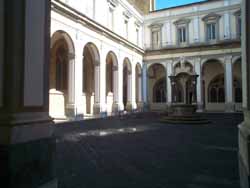 The
present-day Piazza San Gaetano is the site of the original agora
of the Greek city --the forum of the later Roman city of Naples. It
was the heart of the ancient city. Today it is the site of the Church
of San Lorenzo. The
present-day Piazza San Gaetano is the site of the original agora
of the Greek city --the forum of the later Roman city of Naples. It
was the heart of the ancient city. Today it is the site of the Church
of San Lorenzo.
Excavations
beneath the Church and Monastery of San Lorenzo have brought to light
a complex and layered archeological history. About half of the original
Roman market (photo on left) has been excavated and may be seen
by entering through the marked portal next to the entrance to the church,
itself, then passing through the courtyard and going down a flight of
stairs. The site has been open for only about 7 years and is the result
of 25 years of painstaking excavation.
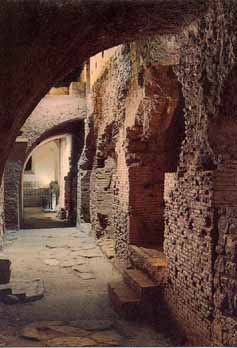 Also, as a result of the excavation, the great hall and three naves
of a sixth century paleo-Christian church have been uncovered, and beneath
the Sala Capitolare of the church a medieval structure has been
found that apparently was one of the small "city halls" of the city.
It was razed around the turn of the millennium and portions of it are
built into the foundations of the newer church of San Lorenzo on top.
It all rests on the original market place of the city from the fourth
century before Christ. The market and streets were used as late as the
fifth century AD, at which time they fell victim to a massive mud slide.
The subsequent construction of the early Christian church on the site
effectively closed them forever. Also, as a result of the excavation, the great hall and three naves
of a sixth century paleo-Christian church have been uncovered, and beneath
the Sala Capitolare of the church a medieval structure has been
found that apparently was one of the small "city halls" of the city.
It was razed around the turn of the millennium and portions of it are
built into the foundations of the newer church of San Lorenzo on top.
It all rests on the original market place of the city from the fourth
century before Christ. The market and streets were used as late as the
fifth century AD, at which time they fell victim to a massive mud slide.
The subsequent construction of the early Christian church on the site
effectively closed them forever.
The market
place is the only large-scale Greco-Roman site excavated in the downtown
area. The site and the surrounding area of the historic center of Naples
are on the UNESCO World Heritage list; that is, it is a site that must
be preserved, at all costs.
Royal
Palace

Overlooking
the Bay of Naples is the long red southern facade of the Royal
Palace. It is one of four palaces that the Bourbons of Naples used
during their rule of the Kingdom of Naples (1730-1860): one is in Caserta,
another at Capodimonte overlooking Naples, and the third is in Portici
on the slopes of Vesuvius. Those three were actually built by the Bourbons.
This one, however, is somewhat older. The building was actually conceived
by Ferdinando Ruiz de Castro, Count of Lemos, Spanish viceroy in Naples
between 1599 and 1603, to be a fitting residence for King Phillip III
of Spain, who was planning a visit to the city. The architect chosen
was Domenico Fontana (1543-1607). The building was put up on the site
of the older Spanish viceroyal residence.
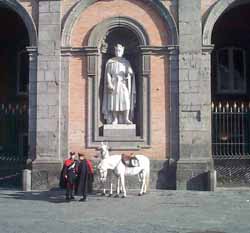 From
the original version of 1600, the palace has undergone numerous architectural
additions and changes, including some by Luigi Vanvitelli in the mid-1700s and then by Gaetano
Genovese in 1838 after a fire had damaged much of the palace. The main
entrance is on the west side of the building on Piazza
Plebiscito, where the facade displays a mini-history lesson: statues
of the rulers of the eight dynasties to rule Naples since the foundation
of the Kingdom of Naples in the twelfth century. They are, from left
to right: Roger the Norman, Frederick
II of Swabia, Charles of Angiò, Alfonse
of Aragon, Charles V, Charles III of Bourbon,
Gioacchino Murat, and Victor Emanuel II. From
the original version of 1600, the palace has undergone numerous architectural
additions and changes, including some by Luigi Vanvitelli in the mid-1700s and then by Gaetano
Genovese in 1838 after a fire had damaged much of the palace. The main
entrance is on the west side of the building on Piazza
Plebiscito, where the facade displays a mini-history lesson: statues
of the rulers of the eight dynasties to rule Naples since the foundation
of the Kingdom of Naples in the twelfth century. They are, from left
to right: Roger the Norman, Frederick
II of Swabia, Charles of Angiò, Alfonse
of Aragon, Charles V, Charles III of Bourbon,
Gioacchino Murat, and Victor Emanuel II.
From the
main entrance you can enter the palace grounds and visit most of the
building. The central courtyard contains the bronze portals that were
once part of the Maschio Angioino
(or Castel Nuovo), and in the inner courtyard there is a cannonball
embedded in one of the gates such that it could only have been fired
from inside! Either that, or, the story goes, the gate was taken as
booty by Charles VIII of France, whose ship was attacked on the way
back to France by the Genoese. The gate was set up to ward off a cannonade
and one of the balls got stuck. The gate was subsequently returned to
Naples by the victorious Genoese and put back in place, cannonball and
all.
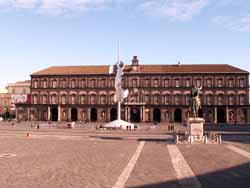 Today
the palace and adjacent grounds house the San Carlo Theater, a museum, the National Library
of Naples and a number of offices, including those of the regional tourist
board. Also, the premises serve for various art shows and exhibits throughout
the year. Today
the palace and adjacent grounds house the San Carlo Theater, a museum, the National Library
of Naples and a number of offices, including those of the regional tourist
board. Also, the premises serve for various art shows and exhibits throughout
the year.
An irony
connected with the Royal Palace is that Phillip III never got around
to visiting the city and staying in the house built just for him.
Hercules,
Rock of (Rovigliano, island)
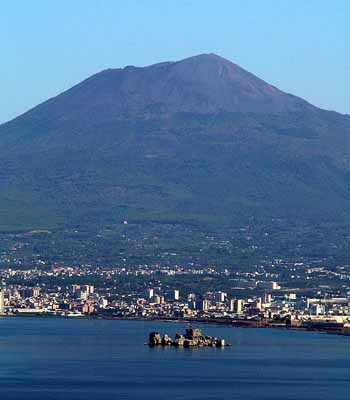 It
is easily seen from shore and just as easily overlooked—this islet
sticking out of the sea 500 yards from the mouth of the Sarno river
at Torre Annunziata near Naples. Hercules, they say, upon his return
from Spain where he had captured the oxen of Geryon (one of his
fabled 12 labours) stopped long enough in the bay of Naples to found
the town of Herculaneum and to sculpt this little rock into the seascape
simply by tossing it out there. In any event, Pliny the Elder (in book
32 of Historia Naturalis) called it Petra Herculis, The
Rock of Hercules, and that is presumably the name the Romans knew it
by. Its current name, "Rovigliano," is of uncertain origin. It derives
either from a Roman family name (owners of the property at some point)
or from the Italian term "robiglia," a common plant found in
the area. It
is easily seen from shore and just as easily overlooked—this islet
sticking out of the sea 500 yards from the mouth of the Sarno river
at Torre Annunziata near Naples. Hercules, they say, upon his return
from Spain where he had captured the oxen of Geryon (one of his
fabled 12 labours) stopped long enough in the bay of Naples to found
the town of Herculaneum and to sculpt this little rock into the seascape
simply by tossing it out there. In any event, Pliny the Elder (in book
32 of Historia Naturalis) called it Petra Herculis, The
Rock of Hercules, and that is presumably the name the Romans knew it
by. Its current name, "Rovigliano," is of uncertain origin. It derives
either from a Roman family name (owners of the property at some point)
or from the Italian term "robiglia," a common plant found in
the area.
The ruins
that one sees are mixed, indeed. As far as I know, there is no real,
physical evidence of the Greek temple to Hercules said to have been
built on the island, although it would make perfect sense for there
to have been such a temple. A bronze statue of Hercules is said to have
been found on the island, as well, but if so, it is lost. The rock apparently
served the Phonecians and Greeks as sort of a trading post in their
dealings with the peoples who inhabited the interior of the Sarno Valley.
There is some later Roman masonry in the ruins, specifically, the brickwork
known as opus reticulatum, the masonry technique that used small
pyramid shaped blocks of tufa set in a core of cement. The tufa blocks
covered the surface, with the pointed end into the cement, so the square
bases form a diagonal pattern that resembles a net—hence the name
"reticulatum" (from the Latin rete, net).
The main
bulk of the ruin comes from the fact that a Benedictine monastery arose
on the property at an uncertain date in the Middle Ages. As late as
the Angevin period in Naples (the 1300s), it was still a very active
and well-known monastery. By the mid–1500s, however, the church
had abandoned the property in the face of ever more destructive incursions
by Saracen pirates. Then, in 1570, the Spanish rulers of Naples converted
the rock to one of the many "Saracen Towers"— well–placed
and well–fortified military installations that served to protect
the coastal waters throughout the entire southern half of the Italian
peninsula for many centuries. From extant descriptions of the fort when
it was finished, it was much more than a simple "tower"; it was a three-tiered
"mini-castle," of sorts, taking complete advantage of the considerable
monastery structures that already existed on the grounds. As a fort,
then, Rovigliano remained important even as late as the Bourbon period
and the Napoleonic wars. At the unification of Italy (1860) it was retired
from military use and since that time has passed from one private owner
to another.
health
care; Aquinas, Thomas
 Maybe
it's natural for a nation of hypochondriacs to have one of the world's
best health-care systems. Who says Italy is a nation of hypochondriacs?
I do. Who says that Italy has one of the world's best health-care
systems? The World Health Organization (WHO), that's who. Maybe
it's natural for a nation of hypochondriacs to have one of the world's
best health-care systems. Who says Italy is a nation of hypochondriacs?
I do. Who says that Italy has one of the world's best health-care
systems? The World Health Organization (WHO), that's who.
My Neapolitan
friends—all of whom are delightful hypochondriacs and for whom
"dolce" in la dolce vita really means spending hours in the pharmacy
looking for new potions and elixirs—all grumble about doctors
and general health services here. I mean, you show up at the ER, your
body ravaged by the ebola virus (that has cleverly disguised itself
as a hangnail), and they will actually make you wait till they pry what's
left of some malingering kid off his motorcycle.
None of
them believe me when I quote the World Health Report 2000—Health
systems: Improving Performance issued by the World Health Organization
in 2001:
| The
World Health Organization has carried out the first ever analysis
of the world's health systems. Using five performance indicators
to measure health systems in 191 member states, it finds that
France provides the best overall health care, followed by Italy... |
The criteria
include: the overall level of health of the population; health inequalities
within the population; how well people of varying economic status find
that they are served by the health system; and the distribution of the
health system's financial burden within the population. Italy is in
second-place in the world.
At the
moment, my own particular body is being ravaged by some sort of infection
of the upper respiratory tract. The doctor came over to the house and
listened, thumped and poked for a while, and then prescribed some medicine.
My outrage that I would have to arrange to pick up the pills, myself,
was somewhat abated by the bill for the house call cum snake
oil: a big, fat, round nothing.
Back to
hypochondria. While he was at the house, the doctor got a call on his
cell-phone. His side of the conversation was this: "Signora, I'm
sure it's not that at all… yes…yes…I know…I
read it, too, but there have been no reported cases in Europe."
The woman had a cough, and Neapolitan scare headlines are just made
for people like that. "Deadly Respiratory Disease Sweeping the World!
We're all doomed!" would be one of the calmer headlines for a local
newspaper this week. The reference is to the recent outbreak of what
is called SARS (Severe Acute Respiratory Syndrome) that has apparently
broken out in parts of China.
Because
of my unselfish and benevolent sensitivity to the feelings of others,
I actually passed on a chance to go and hear some good music at a local
jazz club the other night. The club is on Piazza San Domenico Maggiore, just a few feet from
the spot where, in 1273, the altar crucifix was heard by three witnesses
to speak to Thomas Aquinas after he had completed his treatise on the
Eucharist, complimenting him on a job well done. That, alone, might
have encouraged me to go—and I was feeling well enough—but
I didn't sound well; I still had that hard cough that sounds as if demons
are cracking walnuts in your chest—it gets people's attention.
I could see myself enjoying the music and coughing every now and then
for the benefit of those around me and watching them head for the door
and the nearest all-night pharmacy when I told them that this band wasn't
nearly as good as the one I had just heard in Hong Kong.
Ferdinand
II, King "Bomba"
 Ferdinand II, (1810-1859), King of Naples, was nicknamed
"bomba" (bomb) as a result of his bombardment of Messina during
the political unrest in 1848. By most accounts, the slaughter and destruction
of property was excessive—perhaps not entirely unexpected
from one who was the last absolute monarch in Europe and one who resisted
calls for constitutional government to the very end. He died in 1859
and left the few months of existence remaining to The Kingdom of Naples,
before its forcible incorporation into a united Italy, in the hands
of his son, Francis II. (The son was already known, affectionately,
by the Neapolitan diminutive, "Franceschiello" and, less affectionately,
as "Bombalino"—Little Bomb). Ferdinand II, (1810-1859), King of Naples, was nicknamed
"bomba" (bomb) as a result of his bombardment of Messina during
the political unrest in 1848. By most accounts, the slaughter and destruction
of property was excessive—perhaps not entirely unexpected
from one who was the last absolute monarch in Europe and one who resisted
calls for constitutional government to the very end. He died in 1859
and left the few months of existence remaining to The Kingdom of Naples,
before its forcible incorporation into a united Italy, in the hands
of his son, Francis II. (The son was already known, affectionately,
by the Neapolitan diminutive, "Franceschiello" and, less affectionately,
as "Bombalino"—Little Bomb).
Ferdinand
II was the son of Francis I and grandson of the long-reigning Ferdinand
IV of Naples (also known as Ferdinand I of the Kingdom of Two Sicilies—in
case you were having difficulties figuring out how a IV could come before
a II!). "Bomba" ascended the throne in 1830 and had, at first, the reputation
of a progressive monarch. He was responsible for much of the great industrial
progress in southern Italy, such as the inauguration of the first Italian
railway (from Naples to Portici in 1839) and promoting the significant
commercial and military shipyards at Castellammare. He was, however, totally allergic
to the ideas of a united Italy and political reform that drove the Risorgimento,
the move to unify the Italian peninsula and, above all else, the
idea that defined what it meant to be "Italian" in the 19th century.
See, also:
Naples Under the Bourbons & the Coming
of Garibaldi
Four
Days of Naples; D'Acquisto, S. (monuments); scugnizzo (2)
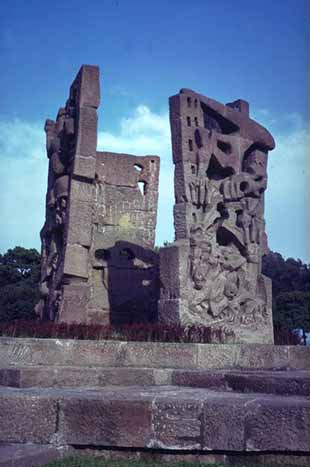 In a city full of baroque and neo-classical statuary,
two rather unusual works of sculpture stand out. One is at the west
end of the Villa Comunale in the center of Piazza della Repubblica near
the Mergellina section of town. It is the memorial to the so-called
"4 Giornate di Napoli" (Four Days of Naples), a popular uprising
in September 1943 against German forces occupying Naples. The
revolt involved Neapolitan "scugnizzi" (street kids), engaged
in harrying tactics against the hard-pressed Wehrmacht, the German
army, already in disarray in the face of the Anglo-American invasion
at Salerno. It is part of Neapolitan lore that such armed civilian resistance
helped drive the Germans from the city. The monument consists of sculpted
monoliths raised on a platform; each slab contains intense detail of
humans involved in war. In a city full of baroque and neo-classical statuary,
two rather unusual works of sculpture stand out. One is at the west
end of the Villa Comunale in the center of Piazza della Repubblica near
the Mergellina section of town. It is the memorial to the so-called
"4 Giornate di Napoli" (Four Days of Naples), a popular uprising
in September 1943 against German forces occupying Naples. The
revolt involved Neapolitan "scugnizzi" (street kids), engaged
in harrying tactics against the hard-pressed Wehrmacht, the German
army, already in disarray in the face of the Anglo-American invasion
at Salerno. It is part of Neapolitan lore that such armed civilian resistance
helped drive the Germans from the city. The monument consists of sculpted
monoliths raised on a platform; each slab contains intense detail of
humans involved in war.
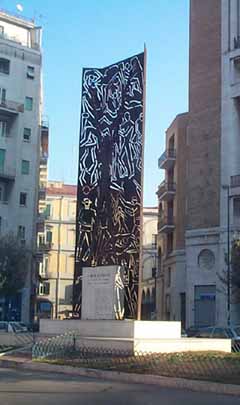
Also,
there is a large metal-wrought memorial on via Toledo (via
Roma) at Piazza Carità, at the north end of the so-called
"Spanish Quarter". It is dedicated to the memory of Salvatore D'Acquisto,
a 23-year-old Carabiniere heroically involved in an incident in September,
1943.
One German
soldier was killed and two were seriously injured when a grenade exploded
in a crate of abandoned munitions they were inspecting. The German
commander was convinced, however, that his men had been killed by
a booby trap set by the Italian resistance. He went to the nearby
Carabiniere station of Torrimpietra near Torre di Palidoro and demanded
of the young officer-in-charge, D'Acquisto, that he find those responsible.
D'Acquisto argued in vain that the incident had been accidental, at
which point the German commander rounded up 22 Italian civilians
to execute in reprisal for the "ambush". At that point, D'Acquisto
lied and took personal responsibility for the incident. He was summarily
executed by firing squad, thereby sacrificing his life for and saving
the lives of the civilian hostages.
Capodimonte
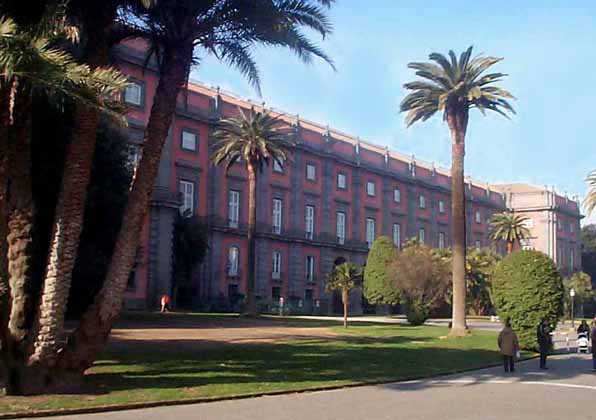
The Royal
Palace at Capodimonte was started in 1738 during the reign of Charles
III of Bourbon. Eventually it would be one of the four such palaces
used by the Bourbons during their rule of the Kingdom of Naples. (The
others are: the Palace at Caserta, another on the slopes of Vesuvius
in Portici near Herculaneum, and, of course, the Royal
Palace in the heart of the city, itself.) The palace and grounds
at Capodimonte were spread over 200 acres of farmland, converting the
land from agricultural use into a vast hunting reserve for the royal
family.
The palace
itself was not completed until 1838. In the interim, of course, the
Napoleonic wars had taken place, one result of which was that the
King of Naples, Joseph Bonaparte (Napoleon’s brother), had a magnificent
new boulevard, Corso Napoleone, built in order to facilitate passage
from the palace to the city. The Bonapartes left the scene, and their
sworn enemies, the Bourbons, returned to find a brand-new avenue waiting
for them. Today that thoroughfare bears the name, Santa Teresa degli
Scalzi.
In order
to provide the proper ecology for prey they wished to hunt, the Bourbons
turned the grounds into a botanical marvel, introducing a vast number
of different plants and trees. Part of the grounds were even turned
into a well-husbanded ‘English Garden’ in the 1820s. Much
of the grounds, however, was kept in a wild and natural state until
the middle of the nineteenth century when broad footpaths were laid,
radiating out from the palace, itself, such as to give the grounds more
the effect of a garden for strolling rather than hunting. Over the years,
a number of secondary buildings were constructed, some of them self-perpetuating
in the sense that they provided agricultural services to maintain the
grounds, themselves. The grounds also housed the Royal Porcelain Works
of the Bourbons. The nearby church is the Church of San Gennaro, ordered
built by Charles III to be the house of worship for the workers involved
in the construction and maintenance of palace and grounds.
Today,
the palace houses a number of significant displays, among which are
the Historical Apartment, the Armory, the Porcelain Room, and, of course,
the items in the collection of the National Art Gallery, a collection
based on one originally belonging to the Farnese family and bequeathed
to the Bourbons in 1731. The current collection is rich, indeed, and
includes Michelangelo, Rembrandt, Raphael, Caravaggio, and Botticelli.
Tasso,
Torquato
 Torquato
Tasso, Sorrento's most famous son, was not in the town on June 13, 1558,
the date of a particularly vicious sacking of Sorrento by Saracen
pirates, one that killed thousands of persons, and saw many more
carried away into slavery. He was fourteen years old at the time and
had already moved away to Rome. [For a related item on the so-called
"Saracen Towers," click here.] Torquato
Tasso, Sorrento's most famous son, was not in the town on June 13, 1558,
the date of a particularly vicious sacking of Sorrento by Saracen
pirates, one that killed thousands of persons, and saw many more
carried away into slavery. He was fourteen years old at the time and
had already moved away to Rome. [For a related item on the so-called
"Saracen Towers," click here.]
The raid,
however, was a pivotal inspiration for his masterpiece Gerusalemme
liberata, still considered one of the great epic poems in
Italian and at the time viewed as the great Epic of Christendom, recalling,
as it did, the First Crusade with its stirring opening:
Canto
l'arme pietose, e 'l capitano/ Che il gran sepolcro liberò di
Cristo—
("I sing the pious arms, and the captain who freed the great sepulcher
of Christ.")
Christians
at the time of Tasso were still almost within living memory of the fall
of the thousand-year old Christian Empire of Byzantium,
and Gerusalemme filled a great need for rousing reminders
of past glories. Tasso was compared to Homer, Vergil and Dante, and
though such comparisions today seem somewhat too enthusiastic, the work
fit the spirit of the times perfectly and was the most popular piece
of Italian literature for years. Nevertheless, Tasso's life was a turbulent
one, for even his masterpiece, in spite of popular acclaim, was
severely criticised by The Inquisition. This disturbed him, as did the
relative failure of virtually all of his other works. Tasso has become
a metaphor of the disturbed misunderstood genius. He made virtually
no money at all from Gerusalemme liberata, and he wandered incessantly,
selling his stray poems. Also, he suffered bouts of depression and madness,
even being locked away for a while.
From a
distance, then, the cliffs and mountains of Sorrento are proverbially
tranquil, yet, they are also a facade, behind which is a violent history
and the life of one such as Tasso, who died in 1595
after a life of disappointment and hardship as much as
one of acclaim.
dog-sitting
 Sorrento
is sublime. What follows is Sorrento, the ridiculous. What happened
to me shouldn't happen to a dog, except that it did, and he didn't seem
to mind—or, really, even be aware that anything untoward
had happened at all. Sorrento
is sublime. What follows is Sorrento, the ridiculous. What happened
to me shouldn't happen to a dog, except that it did, and he didn't seem
to mind—or, really, even be aware that anything untoward
had happened at all.
Only those
who are not dog owners—as I am not—are in a position to
know the truth about the little darlings. There are things that dog
owners—such as my dear friends in Sorrento—never
learn. For example, when they tell you, "Oh, he understands everything
you say," they really believe that nonsense. Now, in spite of the debate
over the language abilities of certain other mammals, most dogs—and
especially my friend's dog, Phaideaux (not his real name)—haven't
got the language centers in the brain known as Broca's area and Wernicke's
area. In fact, they have no areas at all, and in super fact, in the
case of my friend's dog, no brain at all—maybe just a doggie dendrite
or two dangling around at the top of the spine that causes tail and
tongue to go into warp drive at the merest hint of life's two greatest
pleasures, food and elimination. The latter will, for purposes of this
genteel discussion, be referred to as "going walkies". In short,
Phaideax wouldn't know a verb if one started conjugating itself in public.
Oh, Phai
knows when it's time for "walkies," all right. The mere sight of his
leash in a human paw is a signal to go orbital. First, however, comes
the overture to orbital, generally termed "barking". These are not pwayful
widdle woofs, mind you—this is "Dogzilla Triumphant," a great
staccato carnivore of sound ripping chunks out of your central nervous
system. Then come the gymnastics: running around in circles, then back
and forth over the sofa a few times, and finally an impressive series
of vertical leaps calculated to sway that judge on the end who has been
giving the best scores all day to that German Shepherd. Impressive,
indeed, if one is in the mood for true hot-dogs.
But I wasn't.
I just agreed to dog-sit. I got the long list of instructions regarding
feeding time, "walkies" time, etc. etc. Well, actually, not etc. etc.,
for as I said, Phaideaux does just two things. For you Aristotelians
who wish a more formal statement in the terms of symbolic logic (remembering,
of course, that hypothetical and disjunctive premises may combine to
yield a categorical conclusion): Let Phai represent that class of dogs
and only those dogs who do nothing but eat and go "walkies"; thus if
p then r, and if q then r, but either p
or q; therefore…hold on…it occurs to me that I don't
know what I'm talking about. That's ok, that stinking mutt knows enough
about Aristotle for the both of us.)
Anyway,
on the morning of the disaster I am still in charge—top
dog, as it were. I wield absolute power over this mutt. When I
say jump, he jumps. Of course, even if I don't say jump, he jumps, but
that is neither here nor there, although, possibly, it may be somewhere
else.
Now, however,
the dog thickens. Somehow, in the course of a few days, Phai has taught
himself to go "over the wall". There is a gate across the stairway leading
to the wide open spaces. It is of the kind that foils even intelligent
human children. Even four-year old Leonardo da Vinci was stymied by
one just like it. Not Phai. He approaches the gate, where he usually
stops and gives a kind of forlorn doggie sigh before heading back in
for a rematch with the supper dish. This time, however, he nudges the
gate hard enough against the restraining strap to create a small gap
between wall and gate and is off like Clint Eastwood in Escape from
Alcatraz. (I later notice that in my friend's video tape collection,
that film is no longer in the proper alphabetical order. I told you
the dog was stupid.) Anyway, I finally chase him down in the lovely
public gardens of Sorrento, where he is introducing a park bench to
the joys of symbolic logic.
Later in
the day, after he is back in stir—with his video privileges revoked
for the duration—I keep an eye on him. Again, he doggie-saunters
out into the hall, heading for the gate. I, however, have now reinforced
same so that no creature without opposable thumbs could possibly bust
outta dis joint. So, why do I follow him out into the hall, forgetting
to block the only door of the flat open—just letting it idle there
for a few seconds in the breeze before it slams shut behind me?!
Good question.
Here I am, smarted out of my house by a bastardino, as they say
in Italian—roughly translatable as "mutt" and more precisely as
"little bastard". I am caught in a real life shaggy dog story—in
my underwear—and the keys are inside. (The flat, not my
underwear.) Cleverly, I have left spare keys with a friend who has just
left town for the day.
There is
no real ending to this. I spend the next nine hours wrapped in a towel
sheepishly grinning while I try to convince neighbors that I am normal.
Phaideaux grins doggedly, for he is trapped outside with me. This is
serious down time for him, since his food dish is inside. But he makes
the best of it. After all, 9 hours is only 1 hour and 18 minutes in
dog-years.
megaliths
(dolmen)
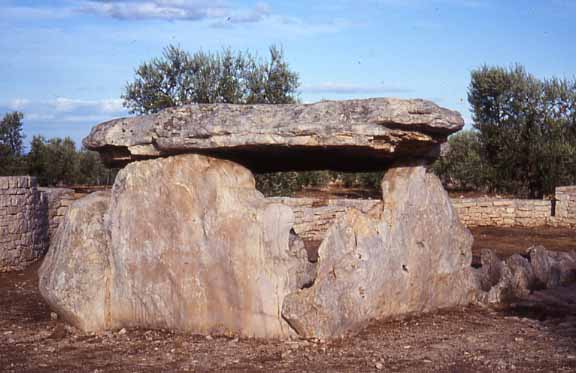 They look as if they were dropped in place by a race of giants.
As a matter of fact, folklore still refers to them in many parts of
Europe as 'tombs of the giants'. Indeed, there are otherwise rational
persons (because they refuse to believe in giants) who will look you
in the eye and tell you that alien creatures with advanced technology
must have levitated these things into place from orbiting spacecraft.
They are 'megaliths'—from the Greek, meaning 'large stones'. The
most famous group of megaliths is Stonehenge on the Salisbury plain
in southern England, but hundreds of other, smaller, sites exist in
Europe from central Sweden down through Spain, France, Italy and the
Mediterranean islands. They are found, as well, throughout Africa, Asia
and the Middle East. Depending on the site, their construction has been
dated back to anywhere between five and two thousand years b.c. Many
of the ones in Europe are closer to the earlier date and are the oldest
examples of European architecture. Their builders are covered by the
term "protohistoric," meaning "just before recorded history". We know
very little about them except that they spent an inordinate amount of
time pushing very heavy stones into place. They look as if they were dropped in place by a race of giants.
As a matter of fact, folklore still refers to them in many parts of
Europe as 'tombs of the giants'. Indeed, there are otherwise rational
persons (because they refuse to believe in giants) who will look you
in the eye and tell you that alien creatures with advanced technology
must have levitated these things into place from orbiting spacecraft.
They are 'megaliths'—from the Greek, meaning 'large stones'. The
most famous group of megaliths is Stonehenge on the Salisbury plain
in southern England, but hundreds of other, smaller, sites exist in
Europe from central Sweden down through Spain, France, Italy and the
Mediterranean islands. They are found, as well, throughout Africa, Asia
and the Middle East. Depending on the site, their construction has been
dated back to anywhere between five and two thousand years b.c. Many
of the ones in Europe are closer to the earlier date and are the oldest
examples of European architecture. Their builders are covered by the
term "protohistoric," meaning "just before recorded history". We know
very little about them except that they spent an inordinate amount of
time pushing very heavy stones into place.
There are
basically two kinds of megaliths: dolmen and menhir. Both
words are from Breton, a Celtic language spoken in an area of northern
France where a great many of them have been found. Dolmen means
"table stone" and menhir "tall stone". Thus, dolmen refers
to a chambered construction, generally a flat table stone supported
on three sides by upright slabs, with the fourth side open as an entrance
to the chamber. In some cases there may also be a covered corridor leading
into the chamber through the open side. The smaller stone slabs arrayed
on either side of the entrance define the corridor leading to the main
chamber. Originally, dolmens served as tombs, either for individuals
or groups, and both chamber and entrance were covered over with cairns
or earth.
Although
dolmens clearly had a funerary purpose and, hence, probably played a
significant part in religious rituals and other ceremonies of the Neolithic
peoples who built them, there is much less unanimity of opinion on the
function of free–standing menhirs, such as the circle at Stonehenge
or those on the Orcadi islands of Scotland. They may have served as
boundary markers, clan identification, or as ceremonial sites. Some
of them, Stonehenge, for example, are astronomically exact, and probably
functioned in ceremonial capacity at certain times of the year, such
as at the solstice or equinox. Some menhirs might even have been phallic
symbols connected to fertility rites. Both menhirs and dolmens have
been found decorated with various spirals or zig–zag designs.
Wooden versions of these monuments existed, as well, but, obviously,
these have been much more vulnerable to the ravages of time than their
stone cousins
Speculation
on who built the megalith monuments of Europe—and why—has
varied over the last few centuries. Scholarly research, employing modern
dating methods, have put to rest a number of earlier theories, such
as that they started on Crete in the third millennium b.c. and spread
out from there. Many monuments along the Atlantic coast of France are,
in fact, older than similar ones on Crete. In the 17th century there
was also a short–lived theory that was quite ready to hold that
the Romans built them as they spread across Europe a mere two thousand
years ago, or that Celtic druids had built them as sacrificial altars.
These ideas are clearly mistaken.
There has
also been some discussion over whether the megaliths originated with
a single Neolithic people or arose spontaneously at the hands of different
tribes at various times and places. Earlier archaeology even spoke of
an age of "the coming of the megalith builders," as if a single people,
obsessed with the idea of erecting monuments to itself, had spread across
Europe and then faded into the obscurity of preliterate history. That
idea is not widely held today, however. The tendency now is to think
that the megaliths are a product of the so–called "Neolithic Revolution".
This term refers to the period during which hunting and gathering cultures
slowly changed over to more stable societies based on agriculture and
animal husbandry.
This change
started in the Middle East in the 9th millennium b.c. and spread westward
into Europe by the 6th millennium b.c. Giving up a nomadic way of life
meant that villages could be built, places where entire generations
of inhabitants would come of age and pass away—and where there
is passing away there has always been —much earlier than even
these Neolithic peoples—a human tendency to mark that passage.
Thus, the monuments were probably put in place over quite a wide span
of time by various peoples who perhaps had no idea that other tribes
were doing the same thing a thousand miles distant.
The presence
of the megaliths has fascinated us, true, but has also attracted the
hostility of the Christian religion over the last two thousand years.
They were often seen as holdovers from paganism, and, as such, a number
of them were destroyed. In many cases, however, they were Christianized,
that is, crosses were inscribed on them, so they might serve as Christian
altars.
They have
been built in our own times, too, but not in Europe. Inhabitants of
Madagascar have been seen to erect dolmens and menhirs by the oldest
'hydraulic' technology in the world—human sweat. So much for the
claim that megaliths could not have been moved without the aid of extraterrestrial
technology.
The heel
of the boot of Italy—that is, Apulia—is rich in megaliths,
particularly dolmens: Giovinazzo, Santa Sabina near Brindisi, Altamura,
and Minerrini di Lecce near Otranto are a few of the many sites. Perhaps
the best preserved and most easily accessible dolmen in the south of
Italy is in an orchard just off the autostrada to Bari, a few
minutes' walk from the rest stop/filling station named Dolmen di
Biscieglie [see photo, above]. It's on the northbound side, so if
you stop on the way down to Bari you will have to walk under the autostrada
and come up on the other side. Walk out the back of the rest-stop and
follow the signs. A small park has recently been built around it and
the site itself is marked by a small plaque to "our unknown forebears".
It is a lonely, potentially eerie, site and if you are given to searching
for affinity with the ages, this is a good place to sit and think about
a few dozen villagers four or five thousand years ago who built this
tomb for their dead and then went back to their daily routine and puzzled
over the mysteries of life and death just the way we do today.
Serao,
Maltilde (1); Vergil (4)
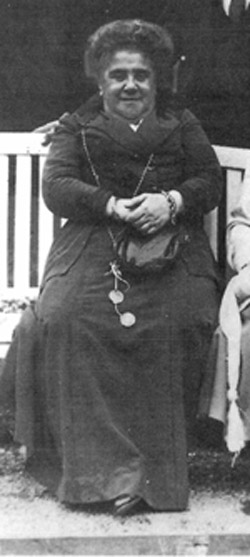 Today
I set out to learn about Matilde Serao, a prominent Neapolitan journalist
and writer from the early 1900s in Naples. That is about all I knew—that,
and the fact that I still had an unopened copy of her Leggende Napoletane
(Neapolitan Legends) lying in wait for me. As with most of these expeditions
of mine to find out stuff, I got distracted very easily—but that's
half the fun. Today
I set out to learn about Matilde Serao, a prominent Neapolitan journalist
and writer from the early 1900s in Naples. That is about all I knew—that,
and the fact that I still had an unopened copy of her Leggende Napoletane
(Neapolitan Legends) lying in wait for me. As with most of these expeditions
of mine to find out stuff, I got distracted very easily—but that's
half the fun.
The biographical
material is straightforward. She was born in 1856 in Patrasso in Greece,
where her Neapolitan father, Francesco, a journalist, had taken refuge
during the Bourbon reprisals in Naples following the political turmoil
of 1848. Her mother, Paolina Bonelly, was Greek. The family returned
to Naples when the Bourbon dynasty ended and the Kingdom of Naples became
part of the larger state of Italy. Serao
graduated from high school in 1874 and got her first job as a telegraph
operator at the post-office. She wrote some early novels of little consequence.
She married the Neapolitan journalist Edoardo Scarfoglio in 1885, with
whom she would eventually have four children. Together, they founded
three newspapers, one of which was Il Mattino (still the largest
Neapolitan daily). She died in 1927.
Serao is
best-remembered as being the type of chronicler of Neapolitan life that
Grazia Deledda and Giovanni Verga were for Sardinia and Sicily, respectively.
She was an intense and accurate observer of the kaleidoscopic mosaic
that was Naples at the turn of the century—from the hard-pressed
underclass to the more affluent Neapolitan petite bourgeoisie,
all of whose lives were bent out of joint by the grand confusion of
the Risanamento, the 30-year project to rebuild the
city, as well as by the problems of a newly-unified Italy and the lingering
and bitter split between North and South. [More on Serao and the Risanamento
at here.] Besides
her newspaper work, she published 40 books. Historian and critic, Benedetto
Croce said that she had an "imagination that is limpid and alive";
Carducci called her the greatest woman writer in Italy; and D'Annunzio
dedicated a novel to her. She was also said to be on the Nobel committee's
short list for the literature prize, an award that ultimately went to
her contemporary from Sardinia, Grazia Deledda.
I already
knew that the Roman poet, Virgil, was said to be a magician. He is connected
with the "egg" in "Egg Castle" as well as with at least one of the old
Roman tunnels in Naples. [Also, see the entry on Virgil.] Perhaps that is why I was attracted
to the section in Serao's Neapolitan Legends that is called "Virgil,
the Wizard". Serao chronicles the many wonders connected with the
poet in Naples. For one, in those days Naples was afflicted with a plague
of flies; Virgil made a fly from gold, breathed life into it, and sent
it on its way. Every real fly it then came into contact with died, and
the plague ended. Virgil also used his powers to dry up the swamps;
he caused the west-wind, Favonianus, to change direction to help the
local vegetation thrive; and he drove away a giant reptile that lived
beneath the hill of Naples. Once, when sickness threatened the horses
in the region, Virgil caused a large bronze horse to be cast; he infused
it with his magical powers, and any horse that would then walk around
the statue three times was cured. And so forth—there are a dozen
or so other legends all connected with Virgil and all brought to life
in Serao's delightful book. (See this entry
for a more recent incarnation of the same legend.)
The most
accessible of her works to a wider audience (because it exists in English
translation) to explore the life of Naples at the turn-of-the-century
is certainly Il Paese di Cuccagna, published in 1891 and, in
English, in 1902, as The Land of Cockayne. It is a humorous account
of the Neapolitan obsession with winning the national lottery.
This is
where I got sidetracked. I did not know the Italian expression "cuccagna".
Even worse, I did not know the English term "Cockayne". They—and
similar expressions in French and Spanish—mean, roughly, "an imaginary
land of plenty". It was used as early as 1305 in English and is possibly
cognate of "cake" or "cook", thus a place where good things to
eat just drop into your mouth.
That sounded
like the "Land of Milk and Honey" to me. Indeed, I had forgotten about
that one. It is in the book of Exodus 3:8: "And I am come down... to
bring them...unto a land flowing with milk and honey." Why, Land
o' Goshen! I said to myself. Yes, Goshen is another Cockayne and is
mentioned in Genesis 45:10 as the fertile land allotted to the Israelites
in Egypt, a place in which there was light during the plague of darkness
and, thus, figuratively, a land of light or plenty.
There is
even a painting, The Land of Cockayne, by Pieter Bruegel the Elder (1525
–1569) in which the most prominent figure is a well-fed and well-drunk
man snoozing it off under a table. His cod-flap is open.
There is
also an expression "lubberland," a place where one is free to be a "lubber"—an
idle lout. I had never heard the expression except in pirate movies
("Avast there, ye scurvy landlubbers!") Finally, it all reminded me
of the hobo ballad "The Big Rock Candy Mountain", various portions of
which I hazily remember as
In
the Big Rock Candy Mountains
There's a land that's fair and bright
Where the handouts grow on bushes
And you sleep out ev'ry night.
In
the Big Rock Candy Mountains
You never change your socks
And little streams of alcohol
Come a-tricklin' down the rocks.
(There's
another verse in here, and then…)
Oh,
the buzzin' of the bees in the cigarette trees
'Round the soda water fountain
Where the lemonade springs and the bluebird sings
In the Big Rock Candy Mountain.
|
And I really
got sidetracked when I learned that the African volcano Oldoinyo Lengai
is known as a real-life Big Rock Candy Mountain, because, unlike other
volcanoes, it doesn't spout forth red-hot lava, but black lava, as liquid
as fresh roofing tar and not really much hotter. It is Earth's only
volcano erupting a carbonate lava instead of a silicate one. Carbonates
are a group of minerals that, 99 percent of the time, form in the ocean,
coming gently out of solution like sugar crystals in old syrup. Thus,
it is a volcano spitting out sweet stuff just ripe for the tasting—if
your taste runs to fresh roofing tar, I suppose.
Don't forget
the Land of the Lotus Eaters from the Odyssey and Tennyson. Eating the
fruit of the lotus makes you lazy, idle and good for nothing.
My head
hurts.
Greek
language (in Italy)
Olden
forms of Greek are still spoken in some villages in the circled areas.
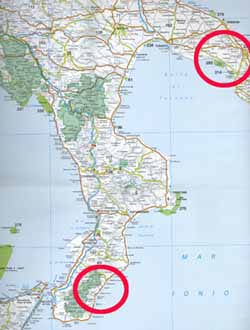 One
of the most fascinating things about southern Italy, linguistically,
is that there are still villages in Calabria where olden dialects of
Greek are spoken. This, you might say, is almost to be expected. After
all, the influence of ancient Greece in southern Italy is evident. The
area was part of ancient Magna Grecia.
It makes sense, then, that there might be a linguistic heritage left
over, even over such a long period of time—although if you think
about it, there are absolutely no places left in Italy where they still
speak any other pre–Roman language, not Oscan, the language of
the Samnites, or even the language of the once mighty Etruscans. In
any case, the first temptation, indeed, is to explain relics of the
Greek language here by saying that they are left over from the days
when Greek sailors settled and built in Sicily, at Cuma and Neapolis. One
of the most fascinating things about southern Italy, linguistically,
is that there are still villages in Calabria where olden dialects of
Greek are spoken. This, you might say, is almost to be expected. After
all, the influence of ancient Greece in southern Italy is evident. The
area was part of ancient Magna Grecia.
It makes sense, then, that there might be a linguistic heritage left
over, even over such a long period of time—although if you think
about it, there are absolutely no places left in Italy where they still
speak any other pre–Roman language, not Oscan, the language of
the Samnites, or even the language of the once mighty Etruscans. In
any case, the first temptation, indeed, is to explain relics of the
Greek language here by saying that they are left over from the days
when Greek sailors settled and built in Sicily, at Cuma and Neapolis.
The problem
is not quite that simple. There are a number of theories that try to
account for the origins of the Greek currently spoken in the south of
the Italian peninsula, a language that is Greek, yes, but not easily
or directly traceable to the language of ancient Greece. Here are some
of the theories, which divide into Early Arrival (EA) and Late
Arrival (LA), the latter having a number of variations:
(1)
EA. They are, indeed, descendants of the settlers of Magna Grecia.
Supporters of this theory explain the differences between ancient Greek
and the Calabrian dialects by pointing out the enormous Latin influence
of the Roman Empire for so many centuries. Also, languages change anyway,
even with no outside influence. Isolation discourages change, true,
but even if the Greeks of yore had crawled into caves in Calabria and
closed the rocks behind them for two thousand years, their language
would still have changed somewhat over that period.
(2)
LA-i. In the last century, an Italian scholar, Morosi, based on
his examination of the dialects spoken in Calabria, concluded that these
people originally got here between the year 900 A.D. and the end of
the 1100s. It has, however, not been possible to settle the dispute
between EA and LA solely by examining the dialects, themselves. Other
evidence must be considered. In Byzantine writings, for example, there
are two references made to settlements in Italy during this period.
The first is to the reconstruction and settling of the city of Gallipopoli
during the reign of Basil I at the end of the 9th century, and the second
is a statement that Basil settled in Longobardia 3,000 former slaves
from the Peloponnesius.
(3)
LA-ii. The presence of Greek speakers in Italy might be due to the
influence of the mighty Byzantine Empire under Justinian. From the middle
of the 7th to the middle of the 8th century, of the 13 Popes in Rome,
eleven of them were Greeks. Justinian made it a point to fill the position
with Greek speakers because he felt they would better carry out the
policies of Constantinople on the Italian peninsula. Also, there was
a vast combination of Greek administrative officials, ecclesiastics,
eastern merchants, and pilgrims from Greece and Syria, all of whom contributed
to what some historians have termed an "oriental elite" in Rome.
Thus, the
line goes, Rome, itself, was very Byzantine Greek by the 7th century.
But, the counterargument goes, Latin and Roman tradition was still strong,
and just how pervasive could the influence of a so-called 'oriental
elite' have been in the outlying areas of the southern part of the peninsula?
One would not expect Byzantine clerics and bureaucrats to move into
the southern mountains and start families. It is possible, however,
that when the Lombards—the last Germanic tribe to sweep down over
the peninsula—displaced the Byzantines, Greek–speaking refugees
from central Italy fled south to settle in Calabria.
(4)
LA-iii. It all has nothing to do with ancient or Byzantine Greeks.
They are here because there was an influx of a considerable number of
Greek-speaking elements from the East as a result of Arab conquests
in the 7th and 8th centuries. The key word here is 'considerable'. Who
knows? Although these invasions of the eastern provinces of the Byzantine
empire probably pushed some Greek speakers west, there is no documentation
of a mass migration, so this is somewhat of a speculation on what might
have been possible.
A variation
on this is that when the city Alexandria capitulated to the Arabs in
642, a considerable part of the Greek population left. Some of them
may have reached the west. There are two pieces of evidence for this:
| —The
frescoes in Santa Maria Antiqua in Rome consist of five layers;
the iconography in the second one is not only Greek, but specifically
of the Alexandrian school. Thus, the logic runs, it could only
have been painted by Alexandrian priests.
—Also,
there are Greek liturgical manuscripts extant in Italy; iconography
and manuscripts are evidence of Greek influence from a specific
period. (They are not, however, evidence of the mass migration
which must have been necessary in order to produce entire Greek
speaking enclaves on the Italian peninsula.)
|
It is also
true that during the Arab conquest of Syria and Palestine that many
Greeks abandoned their homes. It is not clear, however, where they went.
However, thousands of displaced Greeks who were living in North Africa
at the time of the Arab conquest, might have had no recourse but to
flee across the sea to Sicily and the southern Italian mainland.
(5)
Late Arrival-iv (This one looks like a winner in the opinion of
your humble scribe): Bulgars, Avars and Slavs invaded the Balkan
peninsula before, during and after the reign of Justinian (i.e., for
virtually the entire 6th century). This produced a series of fearful
convulsions, any number of which would have been enough to send thousands
fleeing across the seas. This is confirmed by the Chronicle of Monemvasia,
a document written at the end of the tenth century, and which draws
on an earlier source, written shortly after the events occurred. It
has been called an 'unimpeachable source' of description of the Avar
and Slav penetration of Greece and the subsequent dispersion of the
Greeks around the year 600. To wit:
| …In
another invasion they (the Avars) subjugated all of Thessaly and
Greece… they made also an incursion into Peloponesus, conquered
it by war, driving out the noble and Hellenic nations. Those among
the Greeks who succeeded in escaping… dispersed themselves
here and there. The city of Patras emigrated to the territory
of Rhegium in Calabria … some sailed to the island of Sicily
and they are still there in a place called Demena, call themselves
Demenitae instead of Lacedaemonitae and preserve their own Laconia
dialect. * |
This is
evidence of an immigration to Sicily and southern Italy toward the end
of the sixth century, not from the eastern provinces of the Byzantine
Empire, but from Greece itself. As the Slavs occupied virtually all
the western part of the Peloponnesus, the population who managed to
flee could find no nearer haven than Sicily or Italy.
[I have
drawn much of the above information from,"On the Question of Hellenization
of Sicily and Southern Italy during the Middle Age"' by Peter
Charanis, in The American Historical Review, No. 52, 1946. *
The cited material of the next-to-last paragraph is from that source.
For more on the Greek community in Naples, click here. For an entry on the diffusion of
Magna Grecia, click here.]
Catacombs
(1)
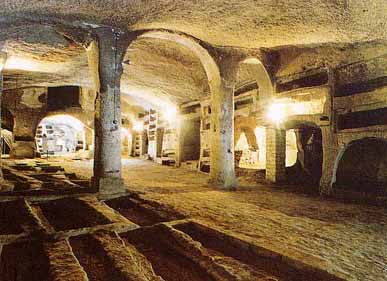 Inside the upper catacomb of St. Januarius
Inside the upper catacomb of St. Januarius
The Catacombs
of San Gennaro (St. Januarius) are the most important paleo-Christian
ruins in Italy south of Rome. They are situated on the slope leading
up to Capodimonte. In early Christian days, there
were actually three cemeteries, dedicated, respectively, to San Gaudioso,
San Severo and San Gennaro. The three
grew together and are now known collectively as the Catacombs of San
Gennaro. The catacombs are different from their Roman counterparts in
that they have much more spacious passageways along two levels. The
lower level is the oldest, going back to the 3rd-4th century and may
actually be the site of an earlier pre-Christian cemetery later ceded
to the new sect. It apparently became an important religious burial
site only after the entombment there of Bishop Agrippino. The
second level was the one expanded so as to encompass the other two adjacent
cemeteries. The site was consecrated to Gennaro
(Januarius) in the fifth century on the occasion of the entombment of
his earthly remains there. The remains were later removed to the Cathedral
of Naples, where they are still housed. Until the eleventh century
the catacombs were the burial site of Neapolitan bishops. Between the
13th and 18th century, however, they were the victim of severe looting.
Restoration of the catacombs was made possible only after the transfer
of skeletal remains to another cemetery.
|
